Authors
Loes van der Graaf and Hanna Siarova
Multifaceted Threats to Biodiversity in Central Asia
Abstract
Biodiversity is an integral part of the earth’s ecosystem. Changes in animal species, temperature, water resources or soil composition directly affect the existence and habitats of flora and fauna. In Central Asia, local ecoregions and biodiversity are strongly affected by human behaviour in the region (agriculture, poaching) and by global trends in climate change. The case study of the snow leopard demonstrates that the supra-national and multi-dimensional challenges to its habitat create a challenge for individual countries to effectively regulate and implement preservation policies.
Keywords: Biodiversity, ecoregions, snow leopard, agriculture, climate change
Introduction
Sir David Attenborough, famous for his movie “A Life on our Planet” recently called upon the United Nations to invest no less than 500 billion USD per year to protect the biodiversity of our planet. “Our natural world is under greater pressure now than at any time in human history, and the future of the entire planet – on which every single one of us depends – is in grave jeopardy”, he claimed.
The ecosystem of our planet serves humanity by ensuring the sustainability of human life on earth. It comprises the habitat in which living organisms (such as animals, plants, and microorganisms) interact with non-living factors such as soil, water, and temperature. The services provided by the ecosystem include the provision of oxygen, water supply, clean air, food, and raw materials for production. A unique feature of the planet’s ecosystem is its balance and interconnectedness. Living and non-living elements depend on the stability of each other to remain in place. For example, the removal of grass or water influences the livelihood and existence of animals who depend on it for nutrition. An increase in temperature melts polar ice and thereby affects the water levels and livelihoods across the globe.
Within the global ecosystem, biodiversity plays its own role in sustainability and balance. An increase in a certain animal species can cause a decrease in, or damage to natural resources and requires an increase of its natural predators to restore balance. The disappearance of a species can have detrimental effects on the existence of others, for example in case of bees who play a crucial role in the pollination of plants.
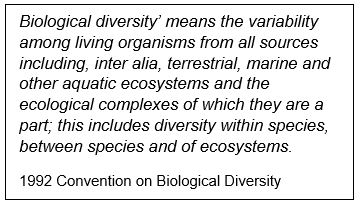
Throughout history, many natural occurrences have affected ecosystems and biodiversity, such as meteorite strikes, the ice age, volcano eruptions, etc. However, nature has usually found a way to restore balance. Currently, biodiversity on earth faces a far more significant threat, namely unsustainable human consumption and production and related climate change. The continuous human impact on temperature, water supply, and livelihoods over the past decades prevents our ecosystem from restoring its balance. As a result, various animal and plant species have already gone extinct.
Biodiversity in Central Asia
The countries of Central Asia (Kazakhstan, Kyrgyzstan, Tajikistan, Turkmenistan, and Uzbekistan) cover a wide range of ecoregions ranging from steppe grasslands to glacier mountains. Every ecoregion has its own characteristics and subsequently houses a variety of animal and plant species that thrive in its conditions. Most of Kazakhstan, Uzbekistan and Turkmenistan are covered by desert, semi-desert, and steppe, while Kyrgyzstan and Tajikistan host more woodland and alpine ecoregions.
Figure 1 A map of different ecoregions in Central Asia
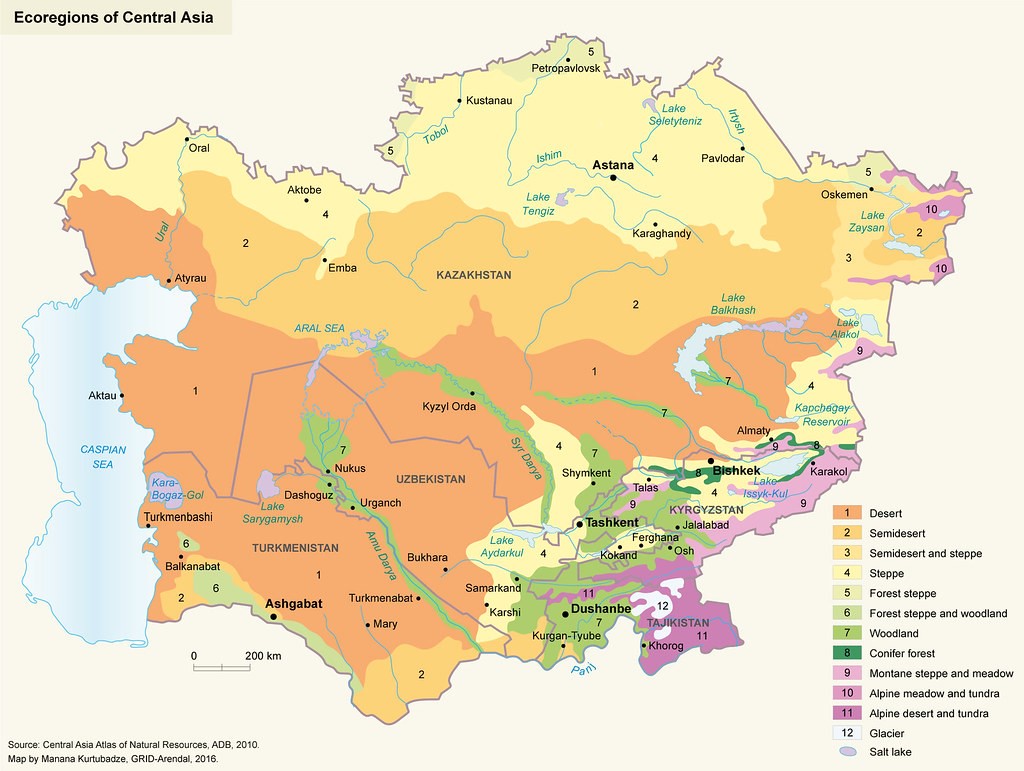
Source: Manana Kurtubadze (2017) “Ecoregions of Central Asia” From collection: Outlook on Climate Change Adaptation in the Central Asian Mountains. Accessible via: https://www.grida.no/resources/11159
Central Asian ecoregions are also influenced by neighbouring ecoregions and bioregions, such as the Siberian boreal forests to the north, the Himalaya to the north-east and the near-eastern highlands in the south-west. However, the ecoregions of the Central Asian steppes and Tien Shan and Pamir mountain ranges are considered unique on our planet.
As a result of its diverse ecoregions, Central Asia hosts various animal species which are predominantly, or solely, found on its territory. A 2001 biodiversity assessment listed more than 900 vertebrate species, including 172 mammals, 540 birds, 106 reptiles, 14 amphibians, and 150 fish. Important animal species found in Central Asia include the snow leopard, Persian leopard, steppe eagle, Bactrian deer, saiga antelope, and Caspian seal.
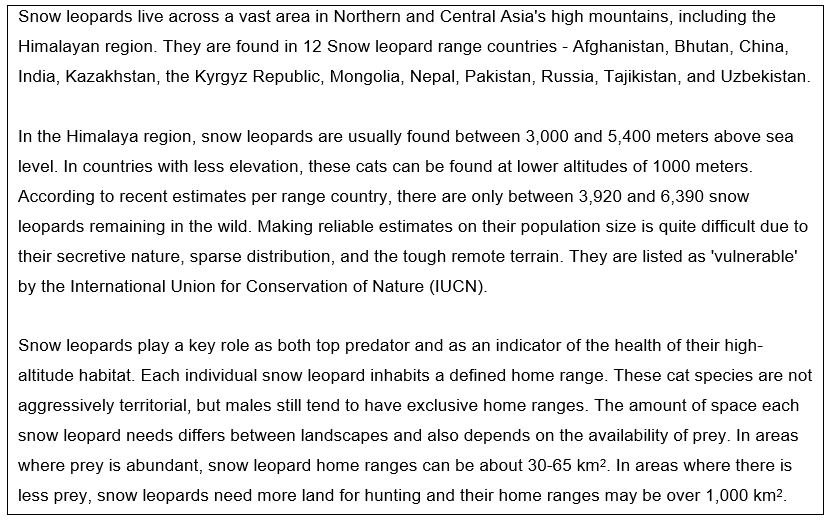
Source: Snow leopard trust, accessible at: https://www.snowleopard.org/snow-leopard-facts/habitat/
Additionally, the region hosts more than 7000 species of high plants. The mountain ecoregions alone support over 5 000 species of vascular plants, of which 25% are endemic. In fact, 20% of the region’s plants are considered endemic. Central Asia also still hosts a variety of ancient fruit and nut tree forests, such as wild walnut, apple, plum, pistachio, cherry, hawthorn, and almond.
Challenges to biodiversity in Central Asia
Since the previous century, biodiversity in Central Asia has come under increased threat by both direct human intervention (e.g., agricultural mismanagement) and indirect intervention (e.g., climate change). Researchers found in 2020 that in Central Asia overall, biodiversity decreased by 11 species of fish, 12 species of mammals, 26 species of birds, and 11 species of plants over the past 30 years. The 2018 IPBES report indicated that 42% of animal and plant species in Europe and Central Asia have disappeared over the past decade. Since 1990, more than half of the species originally living in the Aral Sea (region) have disappeared due to its decreased size. In 2015, 21% of endemic species in Central Asia were considered as threatened, of which 11% were listed as “critically endangered” by the International Union for Conservation of Nature (IUCN). The IUCN found in 2017 that 155 terrestrial and freshwater species were currently vulnerable, threatened or critically endangered in Central Asia.
Table 1 Number of species considered vulnerable, threatened, or critically endangered in Central Asia, 2017
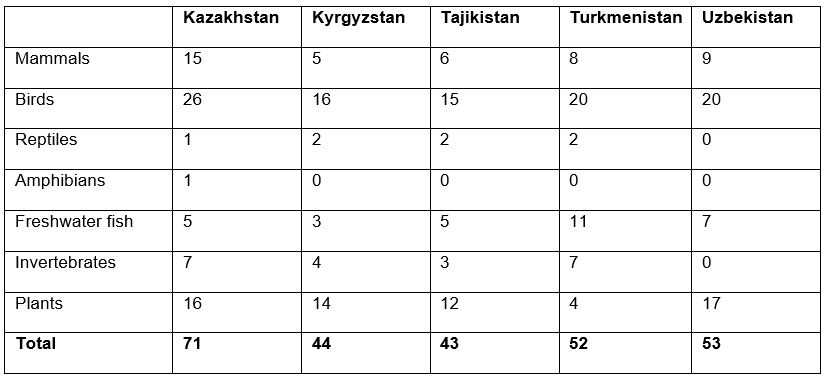
Source: IUCN Red List (June 2017)
Central Asia is characterized by a higher consumption than production of natural, renewable resources and an uneven use and benefit of natural resources by the population. Agricultural mismanagement is a crucial factor affecting land degradation, salination, deforestation and water use in the region. The main challenges to biodiversity found in 2001 (and confirmed in later research) include the conversion of steppe to agricultural lands, the unregulated deforestation, and overgrazing by domestic livestock. Central Asian grasslands, for example, have been impacted by agriculture and livestock management. Their decline is detrimental for a variety of animal and plant species that depend on grasslands, such as steppe birds and the Saiga antelope. In particular, a study found in 2020 that the intensification of grazing is expected to cause the loss of half or even all of the naturally occurring species by the year 2100. These agricultural trends, combined with urbanization, have caused a significant decline in livelihoods of various plant and animal species.
A 2011 report by the Zoï Environmental Network places additional emphasis on the decline of water resources and their quality as challenge to the existence of flora and fauna in Central Asia. For example, pollution and invasive species have affected the quality of water in the Caspian Sea and in the Kyrgyz Lake Issyk-Kul. Large-scale exploitation and irrigation use of the Aral Sea has caused a massive loss in its water volume.
Lastly, poaching, unsustainable hunting and illegal wildlife trade form a continuing threat to biodiversity. Besides the general decrease in species vulnerable to hunting, these practices disturb the natural balance of species within an ecoregion, cause distress to wildlife, and decrease natural habitat.
Besides the direct management of habitats by humanity, global climate change also already left its footprints on Central Asian biodiversity. A temperature increase of 1-3 degrees is expected for the next four decades. Increasing droughts, fires and reducing water resources are all affecting the sustainability of animal and plant livelihoods. This occurred despite the warning already in 2000 by the World Wildlife Foundation (WWF) that the existence of two thirds of Kyrgyz and half of Tajik fauna were under threat of is that species are unable to relocate or adjust as swift as the change in their habitat.
Box 2 Threats to the snow leopard population in Central Asia
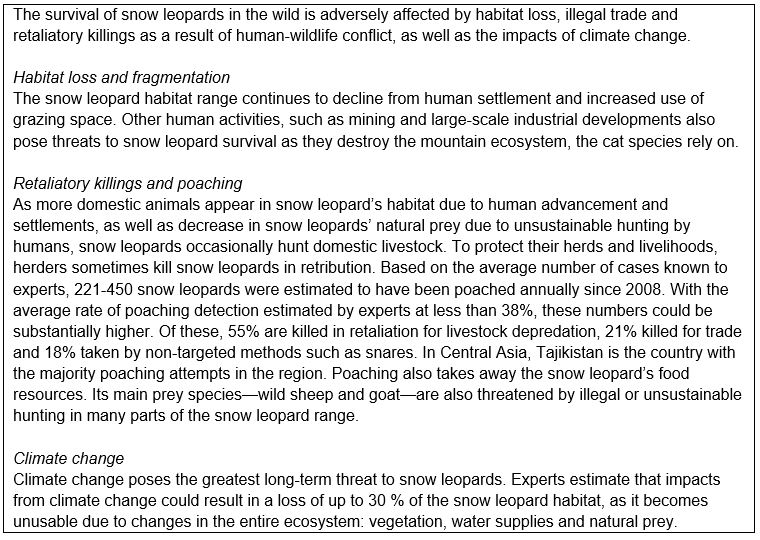
The snow leopard example demonstrates clearly how developments in Central Asian biodiversity are to some extent within direct control of the government (poaching and habitat loss due to human settlement and agriculture) and to some extent outside their direct control (global climate change). Additionally, the example demonstrates that addressing the threats to snow leopards requires a multitude of interventions that also address poverty and economic growth, as well as agricultural reform and sustainability practices in general. In general, the wide (global) scope of threats to biodiversity in Central Asia, and the multitude of sectors involved in biodiversity (agriculture, natural resources, water, economics and poverty) create significant challenges for Central Asian governments to design effective preservation approaches.
Policy responses and recommendations
Although numerous documents concerning the challenges to biodiversity in the region have been published recently, warnings against the threat of climate change and agriculture have been voiced already decades ago. Despite the early identification of loss of ecoregions and their species, insufficient action has been taken to reverse this trend, leading to the disappearance and extinction of numerous species indicated above.
To address the challenges to biodiversity, countries in Central Asia must reconsider and redesign their policies and frameworks regarding the consumption of natural resources and regarding agricultural management. However, governments lack the capacity and political will to do so. Indeed, barriers to sustainable agriculture have persisted since the fall of the Soviet Union and, despite the importance of agriculture in Central Asia, have not resulted in adequate policy reform. An important factor preventing the design and implementation of biodiversity and ecoregion protection systems is the low socio-economic development status of the countries. Natural preservation is simply not a priority for countries that have pressing issues of poverty to address. Additionally, effective protection of biodiversity requires careful planning and rigorous enforcement of laws, as well as reform of agricultural systems and introduction of innovative green industries. These requirements make biodiversity protection extremely expensive and increase the dependency of Central Asian countries on international aid.
The protection of biodiversity by Central Asian countries is subject to four key dimensions that need to be effectively implemented or addressed by the governments. First, a policy framework for protection must be put in place which has sustainability of the ecoregions and their species as main priority. Instead, current regulations related to wildlife and natural resources are mainly designed towards the priority and objective of the national economy. The interconnectedness of preservation of species and policies related to agriculture, economy, and natural resources require states to design a holistic, multipolicy framework which incorporates preservation in different dimensions of governance and policymaking. This requires a common understanding of biodiversity as priority across the policy sectors of the government.
Box 3 Legal and policy gaps in snow leopard preservation
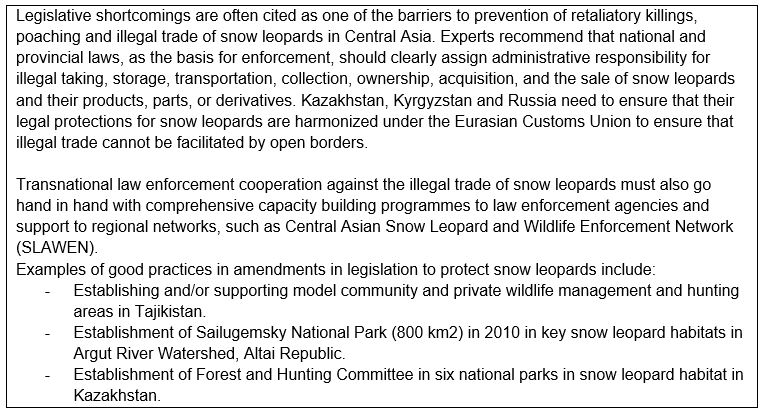
Source: Nowell, K., Li, J., Paltsyn, M. and Sharma, R.K. (2016). An Ounce of Prevention: Snow Leopard Crime Revisited. TRAFFIC, Cambridge, UK.
Once a system for biodiversity and ecoregion preservation has been put in place, the implementation must be monitored and enforced. In this regard, Central Asia is hindered by its general lack of enforcement capacities, lack of monitoring systems, lack of financial tools to fund such mechanisms. A review of existing policies indicates that responsibilities for biodiversity protection are spread across different agencies and involve limited cooperation and exchange of information. As a result, no single agency holds the power to enforce biodiversity legislation (e.g., through arrests, confiscations, searches, evidence collection, etc.).
Low income and insufficient salaries stimulate the acceptance of briberies by officials which undermine the implementation of mechanisms such as allocation of hunting areas and licenses, environmental impact assessments and concessions for extractives.
A third dimension listed in various reports on biodiversity in Central Asia includes the limited knowledge on the topic. Impact assessment conducted for policies and projects rarely cover the biodiversity dimension and therefore do not present how biodiversity would be affected by such initiatives. Additionally, it is not yet fully known how trends such as climate change will influence biodiversity in the future. For this reason, the FAO calls on an increase and strengthening of research, education, capacity-building and multi-stakeholder cooperation programmes for evidence-based policymaking with the involvement of cross-sectoral stakeholders (for the holistic approach to biodiversity presented above).
Lastly, it must be noted that only few of the challenges for biodiversity and ecoregions can be addressed by countries or stakeholders single-handedly. As species and regions are not bound by country borders, international approaches and transboundary conservation initiatives are crucial for the effective protection of biodiversity. Several such initiatives already exist on a bilateral or multilateral level, targeting specific ecoregions or species (e.g., for the Tien Shan Mountains in Kazakhstan, Kyrgyzstan and Uzbekistan, the Pamir-Alai region in Kyrgyzstan and Tajikistan. However, climate change adds another focus on more comprehensive international cooperation with a world-wide scope.
Besides multi-country cooperation, the implementation of biodiversity frameworks requires the involvement and support of various stakeholders. The lack of effective government mechanisms put significant responsibility on local communities to lead initiatives for the protection of biodiversity and ecoregion. Civil society organisations have already played an important role in developing initiatives for sustainable resource management or protection of species (e.g., monitoring and protecting goats and sheep in Tajikistan). Furthermore, governments and international organizations should cooperate closely with farmers and agricultural stakeholders since a sustainable approach to biodiversity requires significant input, sacrifice and flexibility from their side. In this regard, governments should be ready to provide funding and subsidies to stimulate sustainable agricultural practices. A lack of involvement of farmers can quickly cause discontent and threaten the already vulnerable civil rest in the region.
Box 4 International cooperation for the preservation of snow leopards
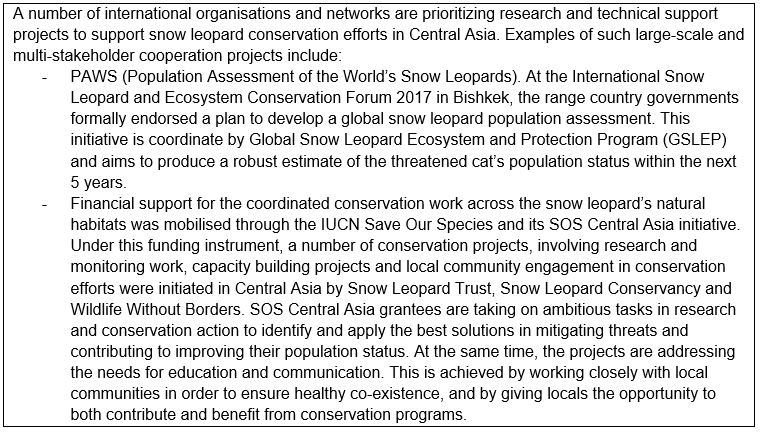
The example of snow leopard preservation initiatives demonstrates the importance of the elements of policy design, policy implementation, research and education, and cross-national and cross-stakeholder cooperation, particularly international cooperation on the monitoring of snow leopard populations. Additionally, the SOS Central Asia programme focuses on benefits for the local community to disincentivize poaching and hunting of snow leopards as means to sustain themselves.
However, a core threat to biodiversity in Central Asia remains the global unsustainable attitude of humanity to consumption and production, which Central Asian countries cannot address or mitigate independently. To design a truly holistic and effective preservation framework for biodiversity, the world itself must commit to reducing its environmental footprint.
Conclusion
Biodiversity in Central Asia is affected by numerous challenges ranging from individual behaviour (poaching); country-level or regional factors (agriculture, natural resource management); and global factors (climate change). The preservation of species is therefore dependent on the ability of governments to integrate biodiversity as priority element for consideration in policy-making across different sectors, and on the ability of governments to cooperate with other countries and a wide range of stakeholders.
However, the example of the snow leopard and of biodiversity in Central Asia in general reflects a more general, global trend. Countries and regions alone cannot combat all threats against ecoregions and biodiversity anymore. The increasing impact of climate change on the habitats of flora and fauna across the world requires a global plan of action, beyond the sphere of work of biology. World leaders must be made aware of the crucial importance of global cooperation against climate change for the preservation of our biodiversity. Steps are being taken and positive developments are noted, but activism against climate change should not stop until human behaviour no longer forms an imminent, global threat against its ecosystem.
References
Abdurakhmanov, k. et.al. (2020) “Ecological problems of Central Asian countries” MOJ Ecology & Environmental Sciences, 5(6)
Australia State of the Environment (2016) “Importance of biodiversity” Accessible via: https://soe.environment.gov.au/theme/biodiversity/topic/2016/importance-biodiversity#:~:text=Ecological%20life%20support%E2%80%94%20biodiversity%20provides,%2C%20hiking%2C%20camping%20and%20fishing
Chemonics International (2001) “Biodiversity Assessment for Central Asia: Regional Overview” Task Order under the Biodiversity & Sustainable Forestry IQC (BIOFOR)
Czarnecki, C. et al (2017) “Best Practices in Snow Leopard Conservation” Advice Document Addendum to the General Guidelines for Climate Smart Snow Leopard Landscape Management Planning. Available at: https://globalsnowleopard.org/wp-content/uploads/2019/01/Addendum-5_-Best-Practices-in-Snow-Leopard-Conservation.pdf
de Haan J., E. Dietzenbacher and V. Hà Le (2013) “Higher government wages may reduce corruption”. VOX, CEPRs Policy Portal. Available at: https://voxeu.org/article/ higher-government-wages-may-reduce-corruption; Armantier O. and A. Boly (2011) “A Controlled Field Experiment on Corruption” European Economic Review 55, pp. 1072-1082; Van Veldhuizen R. (2013) “The Influence of Wages on Public Officials’ Corruptibility: A Laboratory Investigation” Journal of Economic Psychology 39, pp. 341-356
European Commission (2019) “Central Asia” in: Larger than tigers. Inputs for a strategic approach to biodiversity conservation in Asia: regional reports (Luxembourg, Publications Office of the European Union)
FAO (2020) “Status of Biodiversity in Europe and Central Asia – Challenges and Opportunities for Dynamic Conservation of Biodiversity” FAO Regional Conference for Europe, Thirty-second Session Tashkent, Uzbekistan, 5-7 May 2020
International Union for Conservation of Nature (IUCN) Red List of Threatened Species in 2015IPBES (2018) “The regional assessment report on biodiversity and ecosystem services for Europe and Central Asia. Summary for policymakers” Intergovernmental Science-Policy Platform on Biodiversity and Ecosystem Services (IPBES)
Malcolm, J. and Markham, A. (2000) “Global Warming and Terrestrial Biodiversity Decline” Report prepared for the World Wildlife Foundation, accessible via https://wwf.panda.org/wwf_news/?5864/global-warming-and-terrestrial-biodiversity-decline
Manana Kurtubadze (2017) “Ecoregions of Central Asia” From collection: Outlook on Climate Change Adaptation in the Central Asian Mountains. Accessible via: https://www.grida.no/resources/11159
Matthew Green (2020) “David Attenborough leads call for world to invest $500 billion a year to protect nature” World Economic Forum, accessible via https://www.weforum.org/agenda/2020/10/david-attenborough-global-invest-500-protect-nature-iodiversity/
Nowell, K., et.al. (2016) “An Ounce of Prevention: Snow Leopard Crime Revisited” TRAFFIC, Cambridge, UK
Nunez, S. et.al. (2020) “Potential biodiversity change in Central Asian grasslands: scenarios for the impact of climate and land-use change” Regional Environmental Change (2020) 20: 39
PAWS project, accessible via https://globalsnowleopard.org/gslep-projects/paws/
Rosen, T. (2012) “Analyzing gaps and options for enhancing argali conservation in Central Asia within the context of the convention on the conservation of migratory species of wild animal” Report prepared for The Convention on the Conservation of Migratory Species of Wild Animals (CMS), Bonn, Germany and the GIZ Regional Program on Sustainable Use of Natural Resources in Central Asia
Snow leopard trust, available at: https://www.snowleopard.org/the-threats/
SOS Central Asia initiative, accessible via https://www.saveourspecies.org/our-work/sos-central-asia
Zoï Environment Network (2011) “Biodiversity in Central Asia. A visual synthesis” Zoï Environment Network, supported by the Swiss Federal Office for the Environment (FOEN).